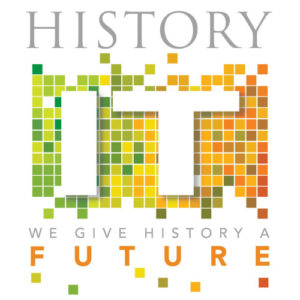What do history and technology have to do with one another? Well, if you think that history is important to us as a society, as I do, then the role that technology plays in how we teach and learn history, how we share stories about the past, is absolutely vital. The conviction that history is important is central to our mission to #savehistory at HistoryIT. Our other core belief is that history is in danger. My realization of this vulnerability and the basic business concept that ultimately became HistoryIT evolved gradually during my 20s and early 30s.
 I have a background in both fields. I ventured to San Francisco during the late 1990s dotcom boom and bust, where I became a self-taught database and web developer. Having studied history and politics, I found it refreshing to work with something as linear and logical as databases, rather than constantly rethinking various interpretations. After a few years, though, the history bug bit me again and I entered a Ph.D. program at GWU in DC. I spent six years completely immersed in the world of research and archives and I never failed to acknowledge what a privilege it was to do so.
I have a background in both fields. I ventured to San Francisco during the late 1990s dotcom boom and bust, where I became a self-taught database and web developer. Having studied history and politics, I found it refreshing to work with something as linear and logical as databases, rather than constantly rethinking various interpretations. After a few years, though, the history bug bit me again and I entered a Ph.D. program at GWU in DC. I spent six years completely immersed in the world of research and archives and I never failed to acknowledge what a privilege it was to do so.
As a graduate student and in the years immediately following, I visited hundreds of archives. I had the training and the time to sift through paper – lots and lots of paper – and think about the stories they contained. As I marveled at the plethora of content and the vast number of primary sources with which to gather and share stories from the past, I wondered what the future held for these stories, locked away in boxes and folders, waiting for someone with the training, time, and access to come and assemble information into stories. This questioning was the seed of HistoryIT.
After a brief stint with the Chicago University Press, where I tried to blend my backgrounds in both technology and history and mold them into a career, I tried my luck as a consultant. Being able to speak both humanities and technology, I realized, made me a great resource for folks putting together humanities projects that involved technology. Basically, I fixed a lot of broken programs that were the result of the failure for one group to actually understand what the other was needing. After a year of fixing broken things, I wondered what it would be like instead to make things that work. Moreover, I thought about what it would take to harness technology, rather than run from it, in order to make more history accessible to more people. In 2012, I founded HistoryIT.
I was keenly aware that I had only a basic understanding of what was involved in creating, much less managing and growing, a business. I talked with anyone who was willing to speak with me about business strategies. My greatest problem – and one that continues to be a challenge for the company to this day – was how to concisely articulate what we do. My “elevator speech” six years ago would have needed a two-hour elevator ride. Over the years, we’ve whittled it down to this:
We save history. We save history by transforming historical resources (primary sources of any format) to a digital space in which they can be easily searched and utilized by diverse audiences.
In our work to do this, we provide a range of services, including digital strategy on how to fund and build usable digital archives, digitization, tagging, content creation, and a whole lot more. We also have our own software platform and later this year will launch a new hardware line.
We crafted our services, software, and hardware solutions over time, all centered on the core mission to make more history available to more people, and to have that undertaking bring new value and preservation assistance to the organizations who strive to protect that history. We started only with services, but soon realized that there wasn’t a digital platform that could manage digital history in a robust way – most solutions were iterations of analog library management software, which still required a whole lot of skill and time to navigate.
In 2013, deciding to build our own software and gaining some support from the Maine Technology Institute, I decided to move the company home and re-headquartered in Portland, Maine. The company was expanding. We were filling jobs. It was time to come home. It was an exciting year. I realized that the market for organizations that need to save their history was large. It turns out it is absolutely massive.
We grew quickly. In fact, we grew too quickly. We had offices in three states, upwards of 50 FTEs and dozens of contractors. By 2015, we had to regroup. We downsized streamlined processes and devised correlations between overall company size and the needs of our clients at any given time. We are now firmly rooted in Portland and Chicago and able to grow smartly rather than quickly.
In any given week, HistoryIT is juggling a zillion projects and priorities, working to educate organizations about what it takes to truly save history for the future, rolling out new software and hardware requirements, and dealing with whatever new challenges emerge. I think that there are a million such challenges that any entrepreneur faces, and two million that any female entrepreneur faces when growing a company. The only way to survive, indeed to thrive, is through sheer grit. When I’ve taken bold steps to blaze a trail in the world of digital history, I have formed a team of dedicated, hard-working, philosophy-driven people who share this grit and the vision to #savehistory.
Kristen Gwinn-Becker, Ph.D. is Founder and CEO of HistoryIT. With the goal of building truly searchable digital heritage collections, HistoryIT combines its software and services solutions to deliver robust digital presentations that are transforming the way the public will access our collective history. Proving that history truly is everywhere, clients include the National Baseball Hall of Fame & Museum, Historical Society of Washington, DC, University of Indianapolis, Great American Songbook Foundation, Bangor Savings Bank, and several fraternal organizations, including Kappa Kappa Gamma, Phi Mu, and Sigma Alpha Epsilon.



